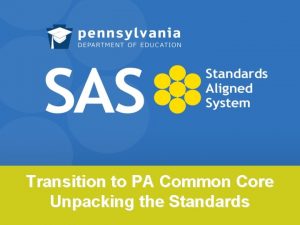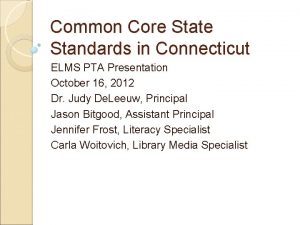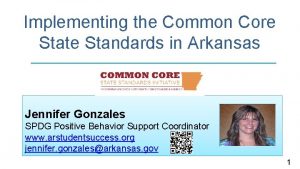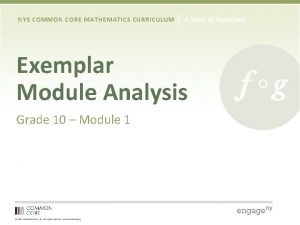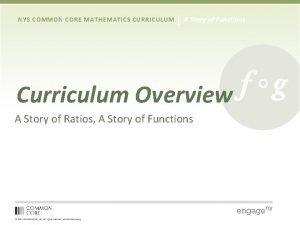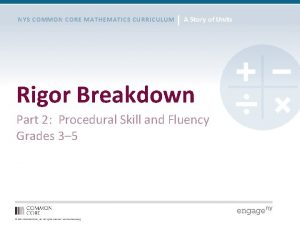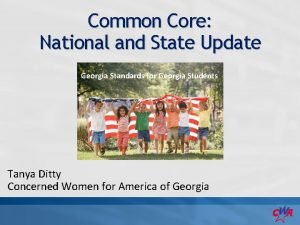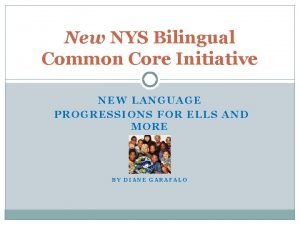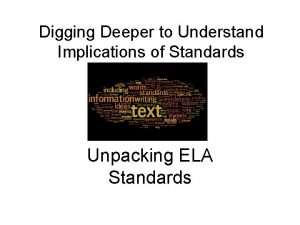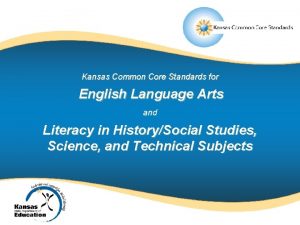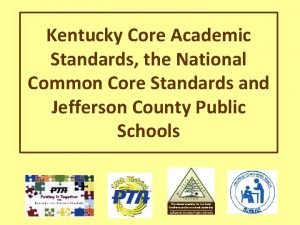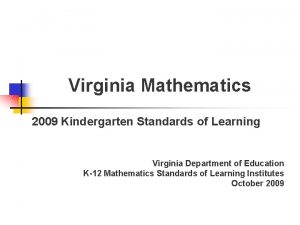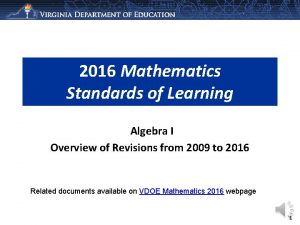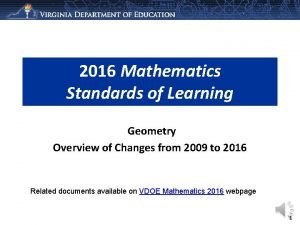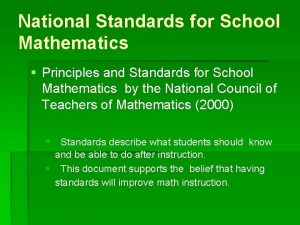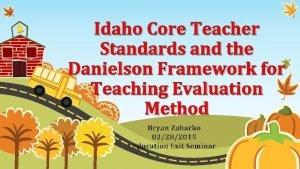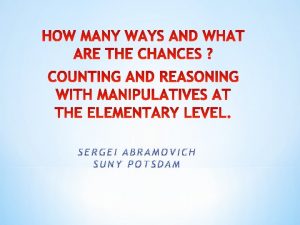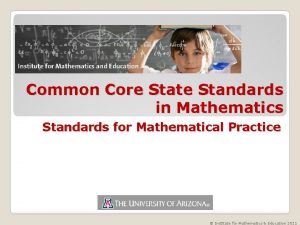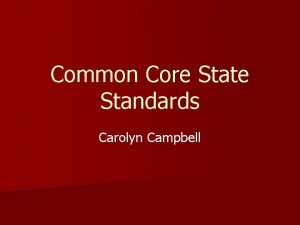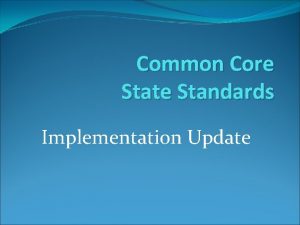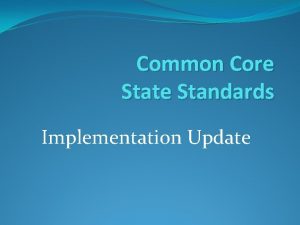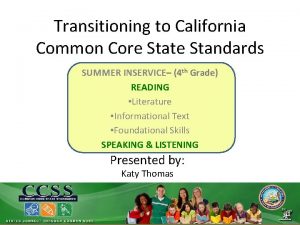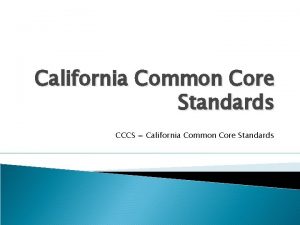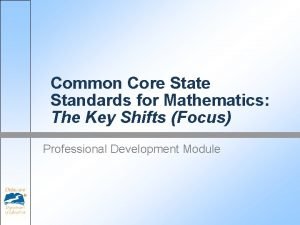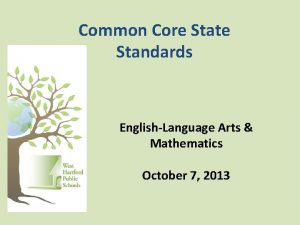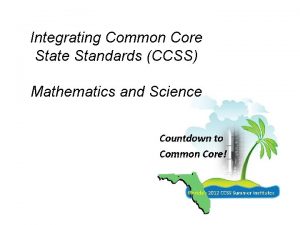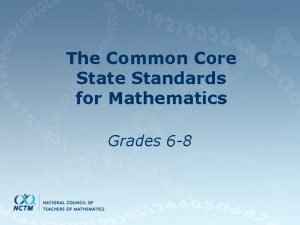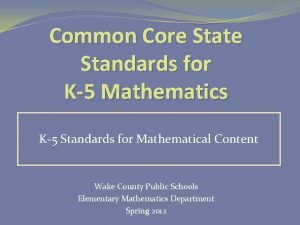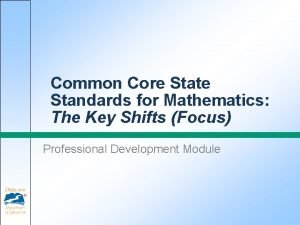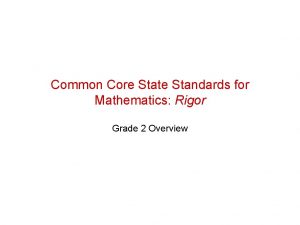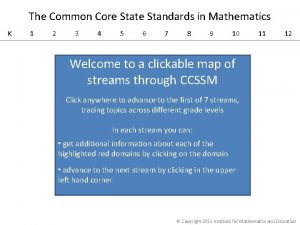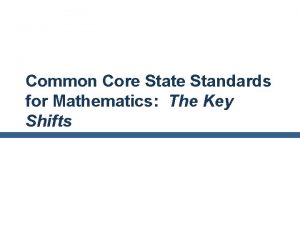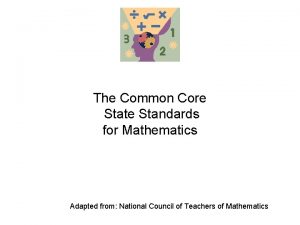Transitioning to Common Core State Standards for Mathematics























- Slides: 23

Transitioning to Common Core State Standards for Mathematics February 29, 2012

Mathematics PD Plan • Face-to-Face • Online • Blended

Mathematics PD Plan • Cognitively Guided Instruction • Extending Children’s Mathematics

Mathematics PD Plan • Data Modeling: Inventing Displays, Center and Precision • 9 -Number and Operations Courses • Other

Mathematics PD Plan • SREB – Mathematics Design Collaborative (MDC) • ADE Math Science Partnerships (MSP) • ADHE Math Science Partnerships (MSP)

K to 1 st • Concept of “ten” • Early experiences with meaning for the operations of addition and subtraction • Developing strategies for addition and subtraction • Fluency with addition and subtraction within 5 • Concept of “measureable attribute” • Foundational understanding of mathematical classification

K to 1 st • Cognitively Guided Instruction • Problem Situations: Addition and Subtraction and the Nature of “Equals” • Problem Situations: Multiplication and Division and the Nature of “Equals” • Developing the Base Ten System • Developing Fact Fluency

st 1 • • • to nd 2 Place Value Understanding Meaning of Addition and Subtraction Properties of Operations Strategies for adding and subtracting Fluency within 10 for addition and subtraction Continuous nature of linear measure

st 1 to 2 nd • Cognitively Guided Instruction • Problem Situations: Addition and Subtraction and the Nature of “Equals” • Problem Situations: Multiplication and Division and the Nature of “Equals” • Developing the Base Ten System • Developing Fact Fluency • Strategies, Algorithms and Recording Systems: Multi-digit Addition and Subtraction

nd 2 • • to rd 3 Place Value Meaning for Addition and Subtraction Properties of Operations Strategies for adding and subtracting Fluency within 20 for addition and subtraction Continuous nature of linear measures Equal shares of identical wholes need not have the same shape

nd 2 to rd 3 • Cognitively Guided Instruction • Problem Situations: Addition and Subtraction and the Nature of “Equals” • Problem Situations: Multiplication and Division and the Nature of “Equals” • Developing the Base Ten System • Developing Fact Fluency • Strategies, Algorithms and Recording Systems: Multi-digit Addition and Subtraction • Fraction Concepts: Equal Sharing

3 rd to 4 th • • Meaning for Operations Properties of Operations Strategies for Operations Fluency for adding and subtracting within 20 Fluency for multiplying and dividing within 100 Fraction meaning Continuous nature of linear measure

rd 3 to th 4 • Cognitively Guided Instruction/Extending Children’s Mathematics • Problem Situations: Addition and Subtraction and the Nature of “Equals” • Problem Situations: Multiplication and Division and the Nature of “Equals” • Developing the Base Ten System • Developing Fact Fluency • Strategies, Algorithms and Recording Systems: Multi-digit Addition and Subtraction • Fraction Concepts: Equal Sharing • Other Problem Situations: Multiplication and Division

th 4 • • to th 5 Meaning of Operations Properties of Operations Strategies for performing operations Fluency with basic facts Place Value Fraction meaning and equivalence Angles

th 4 to th 5 • Extending Children’s Mathematics • Problem Situations: Multiplication and Division and the Nature of “Equals” • Other Problem Situations: Multiplication and Division • Developing the Base Ten System • Strategies, Algorithms and Recording Systems: Multi-digit Addition and Subtraction • Strategies, Algorithms and Recording Systems: Multi-Digit Multiplication and Division • Fraction Concepts: Equal Sharing • Fraction Operations: Multiple Grouping

th 5 • • • to th 6 Fraction meaning Fraction Operations Geometric Classification Extension of place value to decimal notation Lingering concerns…Understanding of operations, strategies for operations and fluency

th 5 • • to th 6 Extending Children’s Mathematics Fraction Concepts: Equal Sharing Fraction Operations: Multiple Grouping Problem Situations: Multiplication and Division and the Nature of “Equals” Other Problem Situations: Multiplication and Division Developing the Base Ten System Strategies, Algorithms and Recording Systems: Multi-digit Addition and Subtraction Strategies, Algorithms and Recording Systems: Multi-Digit Multiplication and Division

th 6 to th 7 • Single Variable Data • Proportional reasoning • Geometric measures: perimeter, area, surface area and volume • Independent and dependent variables • Extending knowledge of number to negative values • Lingering concerns: understanding rational numbers meaning of operations, strategies for operations, fluency

th 6 • • to th 7 Extending Children’s Mathematics Fraction Concepts: Equal Sharing Fraction Operations: Multiple Grouping Problem Situations: Multiplication and Division and the Nature of “Equals” Other Problem Situations: Multiplication and Division Developing the Base Ten System Strategies, Algorithms and Recording Systems: Multi-Digit Multiplication and Division Data Modeling: Inventing Displays, Center and Precision

th 7 • • to th 8 Proportional Reasoning and its application Rational number concepts and computation Statistics and Probability Writing and solving equations

th 7 to th 8 • Data Modeling: Inventing Displays, Center and Precision • Other Coop offerings

Grade 8 and Beyond 8 th Grade Mathematics becomes more like what Algebra I is under the Arkansas Mathematics Frameworks. • Extends rational number system to the real numbers • Function Concepts • Intense study of linear functions • Congruence, Similarity and Pythagorean Theorem

Grade 8 and Beyond Algebra I will finalize linear functions, but most of the instruction will focus on quadratic and/or exponential functions. Algebra II will look a great deal more like what pre-calculus has been under the Arkansas Frameworks.
 Common core state standards pa
Common core state standards pa Common core state standards ct
Common core state standards ct Common core state standards missouri
Common core state standards missouri Common core state standards arkansas
Common core state standards arkansas Nys common core math
Nys common core math Whats common
Whats common Nys common core mathematics curriculum
Nys common core mathematics curriculum Georgia common core standards
Georgia common core standards Nlap standards
Nlap standards Unpacking common core standards template
Unpacking common core standards template Kansas common core standards ela
Kansas common core standards ela Kentucky core academic standards
Kentucky core academic standards Common career technical core standards
Common career technical core standards 2009 mathematics standards of learning answers
2009 mathematics standards of learning answers 2016 mathematics standards of learning
2016 mathematics standards of learning 2016 mathematics standards of learning
2016 mathematics standards of learning Principles and standards for school mathematics
Principles and standards for school mathematics Inner core and outer core
Inner core and outer core The central part of the earth below the mantle
The central part of the earth below the mantle Crust outer core inner core mantle
Crust outer core inner core mantle Core rigidities
Core rigidities National core standards 6 priority areas
National core standards 6 priority areas Idaho core teacher standards
Idaho core teacher standards Bryan zaharko
Bryan zaharko
